There are many aspects in modern board gaming that I personally don’t really care for. For example, I like the card-engine-building of Terraforming Mars or Ark Nova just fine, but they don’t get me excited. I can appreciate the maximum-turn-extending of an Imperial Settlers or Everdell mechanically, but they don’t make me seek out similar games to find out how they do it. However, when it comes to mixing game mechanisms and story telling, count me in! From Maracaibo’s story campaign to Sleeping Gods or more abstract versions of narrative like John Company: Second Edition and Empires of the Void II, story can give a game meaning beyond a single play.
I bought a copy of Lands of Galzyr both because it looked fun but also with an almost academic interest. How had the authors approached the problem of presenting a living, breathing open world in the limiting medium of board games? What would the quality of the writing be like? And would I care for this world?
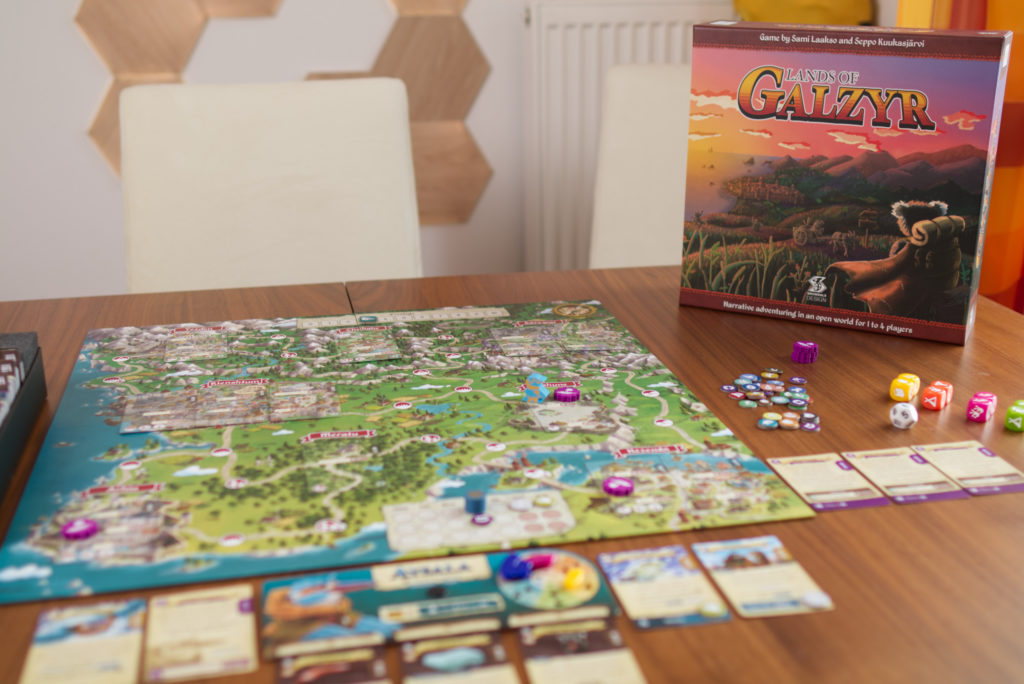
Setup
Getting into Lands of Galzyr feels both easier and more complex compared to something like Sleeping Gods. While the rules are refreshingly short and easy to understand for a narrative adventure game, there is a bit of prep work to be done when setting up the game for the very first time. A whole lot of cards have to be put into numeric order, separators inserted, other cards taken out, shuffled, filed back into other sections, plastic markers inserted into character boards, … luckily this is only needed on first play (or when resetting it for a fresh campaign) and the game is quick to get to the table on subsequent plays.
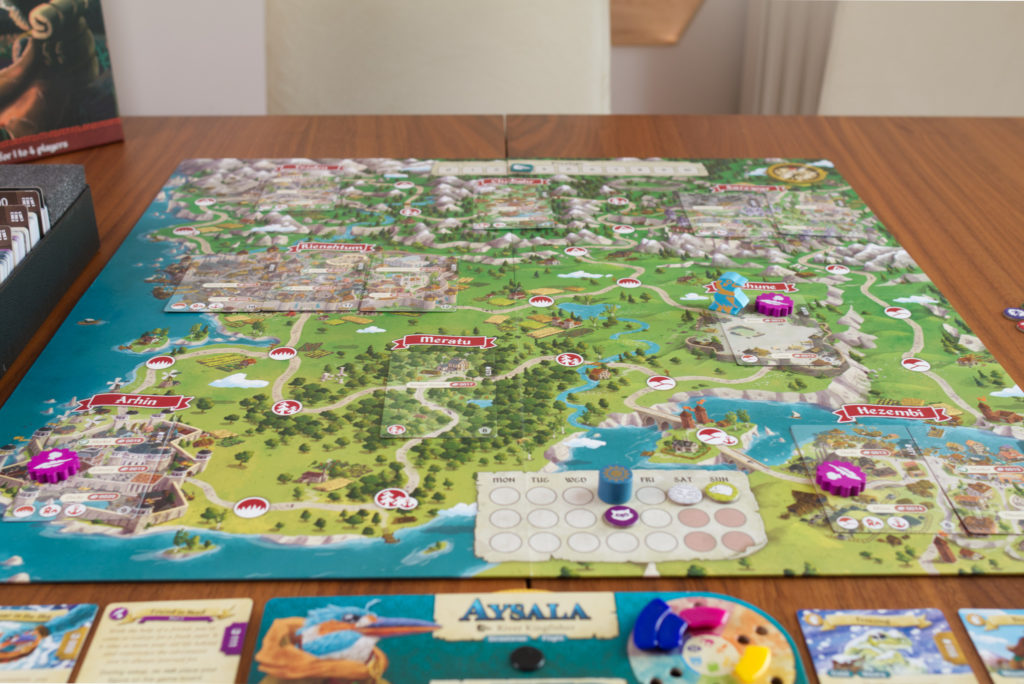
When fully set up, players gather around a refreshingly normal-sized 2×2-fold main board. For some reason, I had expected a bigger map, but that just might be due to the fact that recently a lot of games have gone overboard with their board size. I’m looking at you here Sabika and Encyclopedia! The board has a summer- and a winter-side with paths connecting various cities. Each city has slots for 1-3 matching cards that show locations where players can interact with the world, indicated by a four-digit number. The board also shows a time-track of weekdays where various things will be tracked such as how long a character stays in prison, is wounded or a companion will joining you.
Each player gets a small character board that is used to track the amount of gold that player owns as well as the character traits they have. This is represented by a circle of six colours, each with two slots to slot in matching plastic pieces. At any time, a character will always have exactly four of these plastic pieces but which one can change during the game. If one for example picks Aysala, the River Kingfisher, one is initially particularly perceptive but not so great at fighting. The board also shows two tags, e.g. “streetwise” and “flight” for Aysala that might influence the options the narrative might take when this character gets into an encounter.
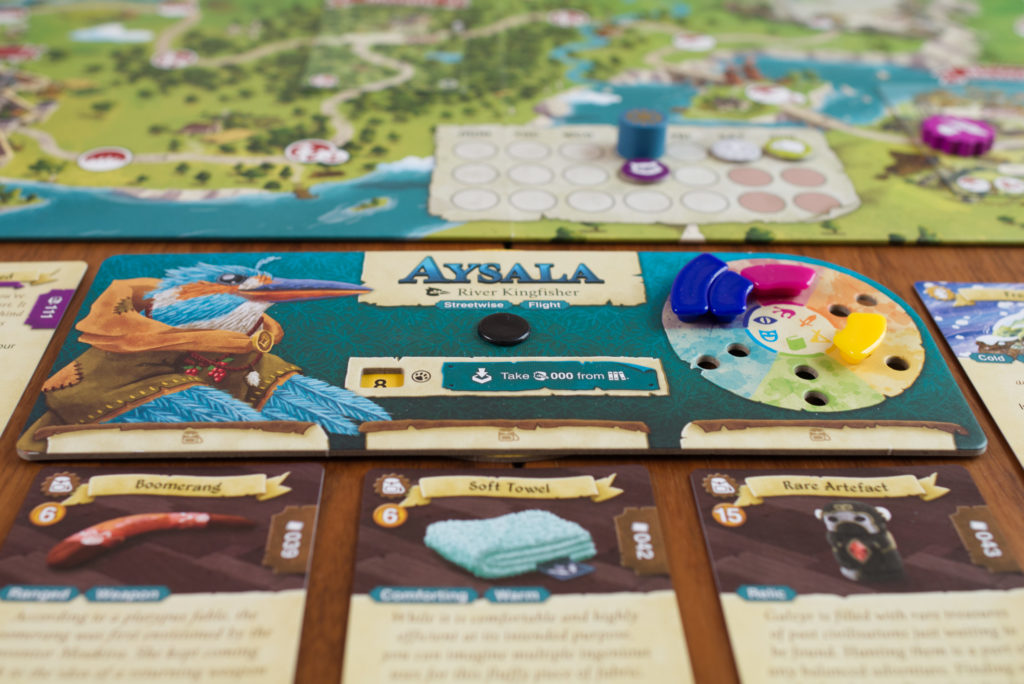
Speaking of story: the main thing missing from the box is its story book. Lands of Galzyr uses a mobile-optimized website instead of a paper book for all story elements. I’m not a fan of app-driven games, but I have to acknowledge that for Lands of Galyzr, it works quite well. It feels more like playing a board game with an accompanying Kindle e-reader rather than playing with an app. But rest assured, you’ll need some form of phone, tablet or computer in reach to play the game. There are multiple upsides to this approach though: errata and corrections can be integrated into it without players even noticing and whenever a animal is mentioned, there is a link to click to get a nice image and description. This especially helps for younger and non-native English speakers.
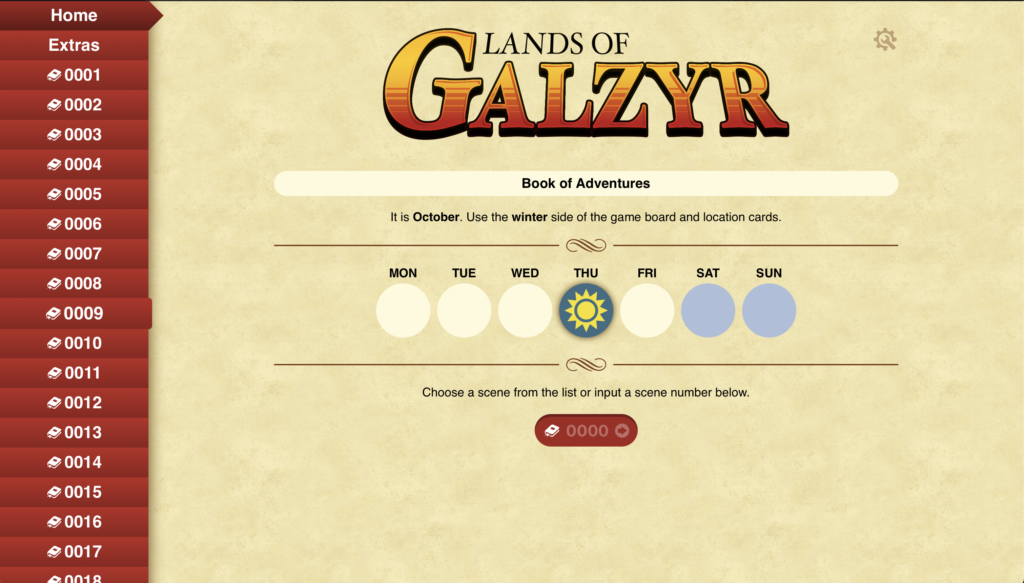
Besides various other bits and bops, the main other component in the game are the two sort-of filing cabinets. One is the library of numerically ordered cards. This contains everything from quests and companions to items and character modifiers. The other is used to capture the current game state when it is time to pack the game away.
Overall, the production is colourful, playful, and contains A LOT of animals. The world is populated by anthropomorphised animals, not a single human in sight. The artwork is well done and leaves little to be desired.
The Turn
On a player’s turn, the player first moves their character’s wooden meeple up to two steps on the map. They can then pick up new quests available in their location and interact with a single story element. This can either be a number printed on a card lying on the board, a quest card the player already owns that told them to go to their current location or if they are in between cities a generic location such as “a mountain” or “the grass land”. In the latter case, an event card is drawn and that reveals what the story number for the type of terrain is.
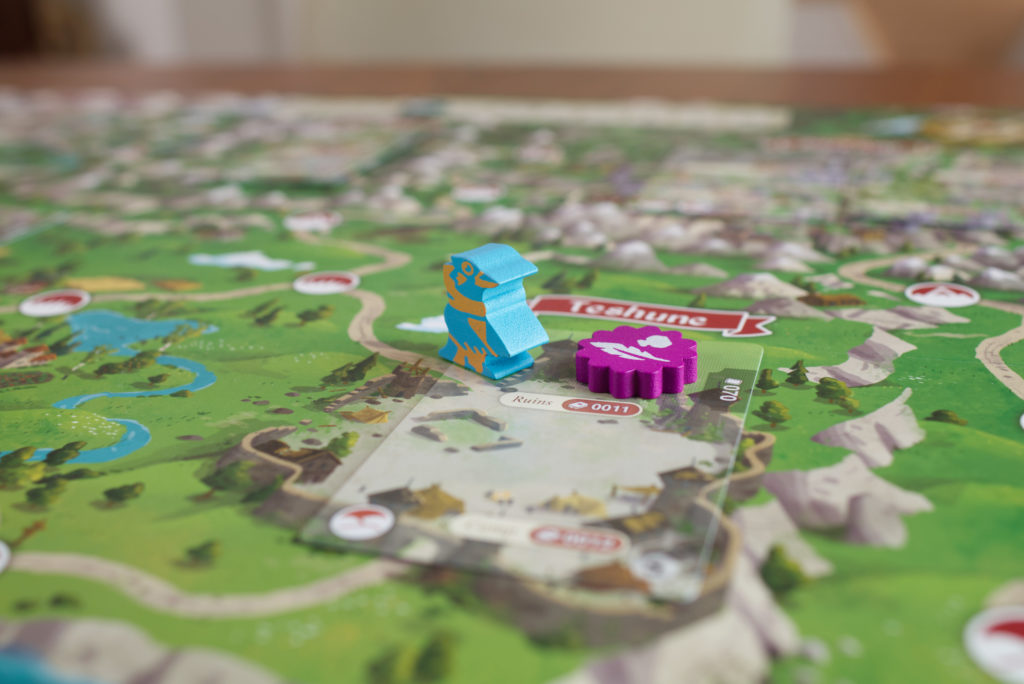
Story elements always follow the same formula: a card tells the player the four digit number to enter into the “story book”, the website gives the players an introduction and then might ask if the player has a certain tag such as “Tinkering” on any of their cards (e.g. items, companions, temporary modifiers). If so, an additional story path is unlocked that wouldn’t be available otherwise.
The player can then choose one of usually 2-3 options on how to proceed in the story. For example, if the player is browsing a library, they might pay money to see an exhibit, look for a certain book, fight with the librarian or just leave. The difference in paths is indicated by the skill against which a check has to be rolled and the level of difficulty (easy/medium/hard). Once the player has made a choice, they have to roll 5 dice. The default black dice have a single skill symbol on each side with all six skills each represented on exactly one side. However, remember those plastic circle bits mentioned in the beginning? Those give the player the option to exchange any black die for a more powerful coloured die. E.g if a character has two dark blue “perception” skill markers, they can exchange two black dice against two dark blue dice that show double perception icons on two of the faces. The remaining four sides each show one of the two neighbouring skills, in the example thievery or communication. So even if the character’s skills don’t perfectly match the requested skill, it is better to use a neighbouring skill’s colour instead of the black default die as it increases the chance of a success from 1 in 6 to 2 in 6.
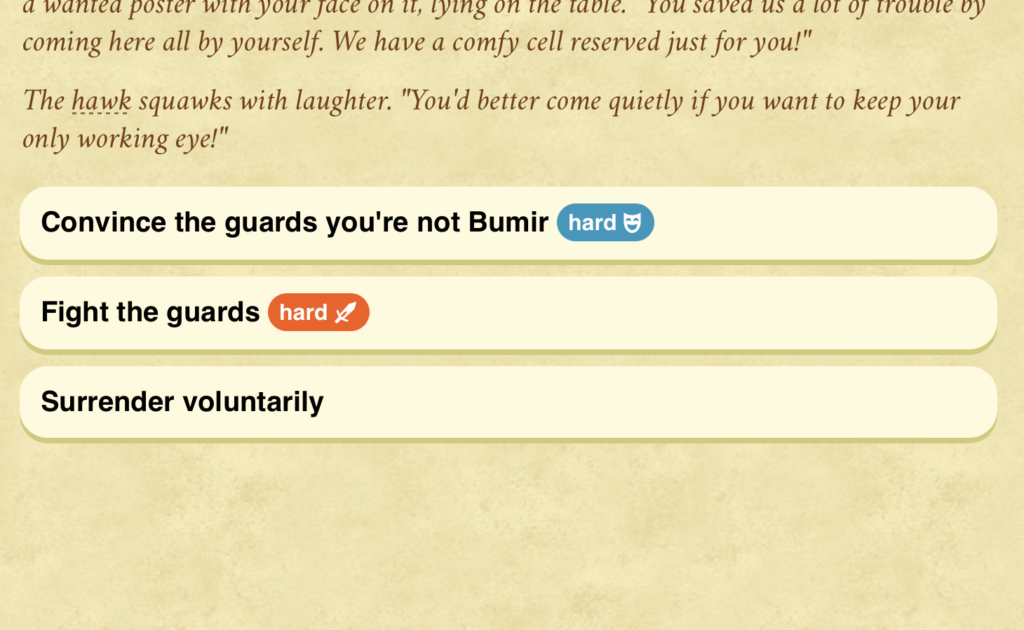
The player pick’s their choice of dice, rolls them and counts the number of symbols matching the skill check. The result is then locked into the story book and the corresponding response will be revealed. For easy, usually 1 matching symbol is already enough, where hard requires 3 matching symbols among the five dice Depending on the items and other cards a player owns, certain checks can be modified. This works by comparing the verb used in the option (e.g. “fight” or “search”) with the verbs printed on the cards. For example, a toolbox allows re-rolling up to 3 dice if the verb was “unlock” or “force”. In general though, expect to be going out of a lot of skill checks either bruised or with nothing happening except having wasted a previous turn.
At the end of a story element, the player will typically file one card back into the library and pick out one or more other cards, for example the next chapter in their quest and an item they gained.
Game End & Player Count
The game ends after a pre-determined number of rounds where players one after the other have performed the turn as described above. For a solo game, a session is 8 turns long for example. Once those have passed, depending on whether or not players decided to play co-operative or competitive, a tallying of “adventure points” will be done to decide who is the most famous adventurer among the players in that session. All cards in play can then be filed away in the box and when players are in a mood to continue, they just get the cards out of the box and restore the world state.
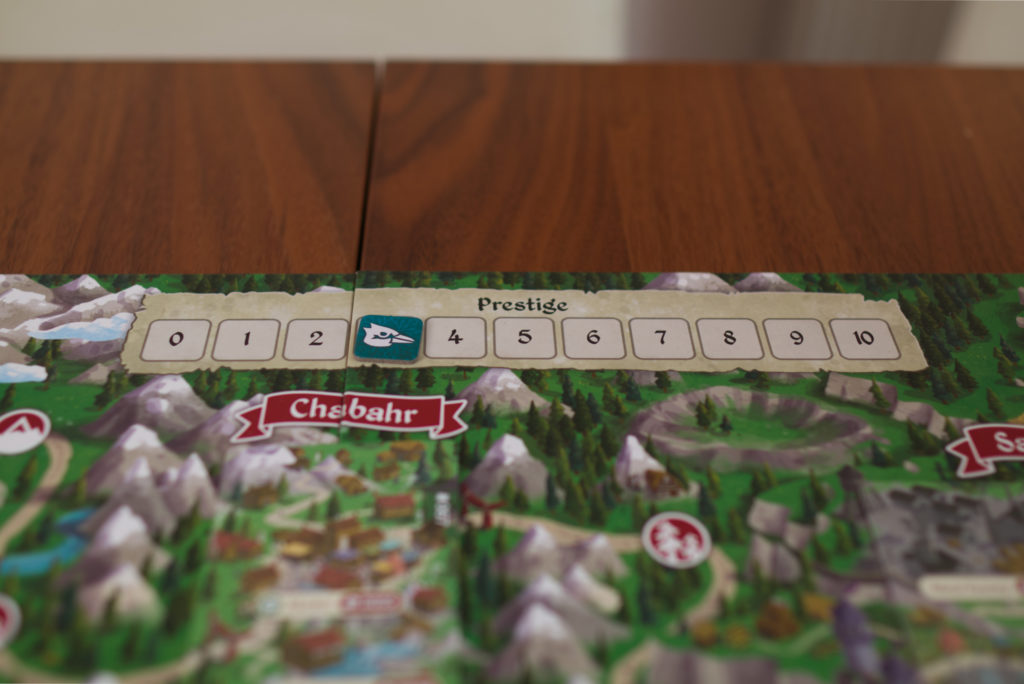
I’ve only played Lands of Galyzr solo and for the most part, the rules read to me like a multiplayer solitaire experience at best. There is a way for players to interact and help each other in certain quests, but it sounded artificial and I wasn’t interested in trying out this mode of play. Note that when playing with more players, the number of turns in a session is reduced.
Conclusion
As always, I’ve left out a lot of details, but that’s the gist of it. While the rulebook initially can be somewhat confusing, the mechanisms of the game are actually quite straight forward. While the very first initial setup is a bit cumbersome, the flow of getting the content out of the box and restoring the world where players left of last time is remarkably smooth. The rather low number of rules also makes this accessible to an audience that would shy away from the complexity of a Sleeping Gods. In some sense Lands of Galzyr feels like the perfect sandbox: just get the box off the shelf, unfold the main board, quickly restore where you left off last time and you’re good to go have another adventure. Fun without end, right?
In order to enable this, Lands of Galzyr needed to make a number of concessions and how much it is a game for you will depend on how you feel about those. For one, there is no over-arching narrative. There is no end to reach, no big baddy to fight, no kingdom to save. Players pick up quests along the way and then follow the bread crumbs, running from here to there to progress the quest to its next step. Once a quest is done, you get “adventure points” (which are only meaningful for the current session), perhaps a new item (a lot of which you have to throw away because you can only carry three), and sometimes the chance to change a skill marker to another skill (but always staying at four in total). But then you have to travel somewhere new, pick up another quest and the old one is soon forgotten.
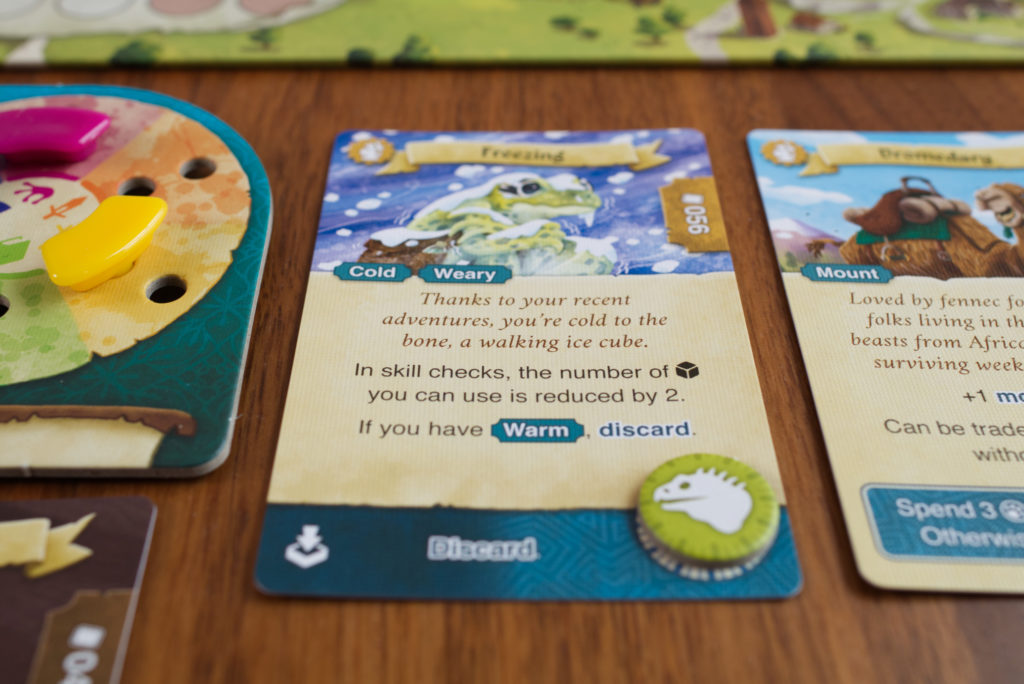
In order to be that infinite sandbox, everything in the long term has to be inconsequential. You break a leg, it heals, you end up in prison, you get out of it, you buy a camel, it’s only rented for three days. In all the sessions I played, the board state for example only changed once with a single card being added to indicate another option at an existing location. Sure, the game tells you to flip the board to its winter side at some point, but that’s been it for me. As a consequence, there can be no progression. Your character will never have more (or less) than exactly four skill markers that modify the dice rolls, it will never have more than 3 items and the ones you get in the beginning are as good as the ones you get after a number of sessions played. While one can specialise their character for a certain set of skill checks and certain verbs, not having any permanent progress robs the players of any sense of achievement.
This can be best illustrated by the end of the game. Players have collected adventure points and see who got the most. But how many you will accumulate in a single sessions depends a lot on luck but also where you left off in the previous session. For example, I started one session being in the right location to complete the last leg of a longer quest I had started previously and that immediately gave me 2 adventure points in my first turn. Compare that to starting a session with a new quest just picked up. It will take multiple turns to complete just that one quest and in-between one only gets adventure points by branching off and exploring things along the way, all of which takes time and lowers your chances to complete the quest within the current session. The arbitrariness of the session end becomes even more apparent in the fact that things like companions or modified attributes are all timed. Cards will often say something along the line of “put a marker 3 days from now” to indicate the camel you rented will be gone in 3 days. What happens if 3 days is one day past the session end? Well, you pack away your camel and next time you start a session, you have a fresh camel that stays 3 days.
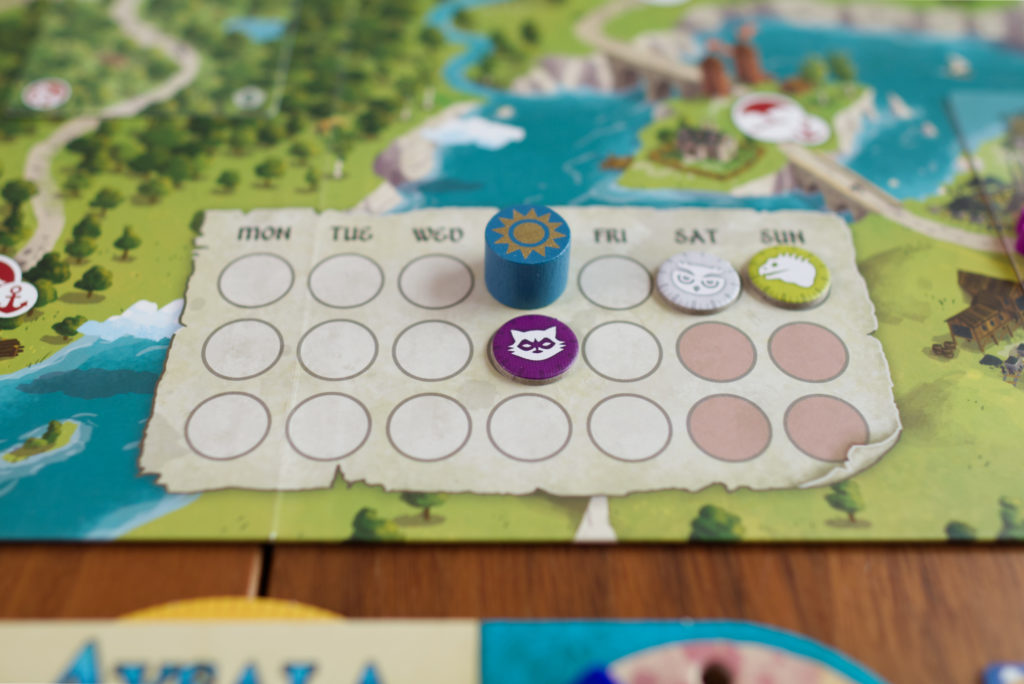
I like the timed-cards idea a lot. This is something I missed in Sleeping Gods because I sometimes wouldn’t complete a quest because the temporary companion I had gained was so useful I never wanted them to leave the ship. So I just didn’t go to their target location, like ever! And they never complained. In that sense Lands of Galzyr feels more immersive than Sleeping Gods, more “logical”. But in all other aspects, I greatly prefer Sleeping Gods to Lands of Galzyr, even if it comes at the cost of more rules and having to find people willing to complete a whole campaign. That’s the main advantage of Lands of Galzyr for me: you can just have a 60-90 minutes adventure in-between and don’t have to plan for a whole campaign. Both games have a rather arbitrary victory point scoring system that I feel should have been simply left out. But Sleeping Gods manages to give me a sense of accomplishment and mementos of the struggles I have passed. I can see that one weapon that did cost me a lot ingenuity to acquire but now is helping me every time I go into a battle. And every time I use it, I remember the fun moment where…
Let’s just leave it there. Sleeping Gods to me is a living, breathing world where every time I play, I gather a new piece that makes it a bit more whole. I can tell you of various gods and folks I met, monsters I have seen, disasters that happened and great victories. With Lands of Galyzr, it is all a blur for me. I couldn’t name you a single town or notable character I met. And that’s not because it is badly written. In fact, I really liked the quality of the writing, it’s excellent! But if something is inconsequential, it is easier to forget and harder to love.
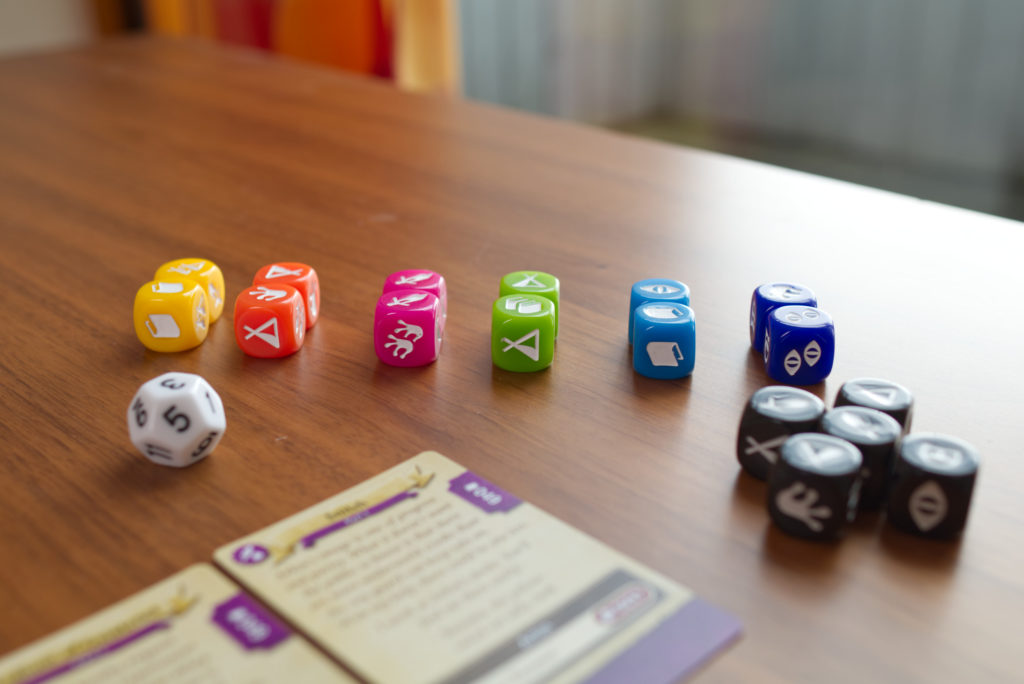
The skill checks also are less interesting than I had hoped. Most of the times, it is obvious which option has the higher probability and which selection of dice to pick for it. If you want to pick the other option, you are often in bad luck because there is no way to compensate for a bad role (unless you happen to have items that match just the verb used). And the tag-system makes each story a case of “hold on, let me scan my cards if I for once have THAT tag anywhere… no, I don’t”. It creates some nice humorous effects such that I could use my umbrella to fight in a situation where no weapons were allowed. But it felt more cumbersome than sparking joy. And most of all, I got annoyed by the amount of time I had to spent searching cards and filing others away. Every time you progress in a quest, it’s a case of put that card away and search for the next one. While saving/restoring the game state in Sleeping Gods is quite cumbersome, it’s only once at the start/end of a session, not while I’m in the flow of playing!
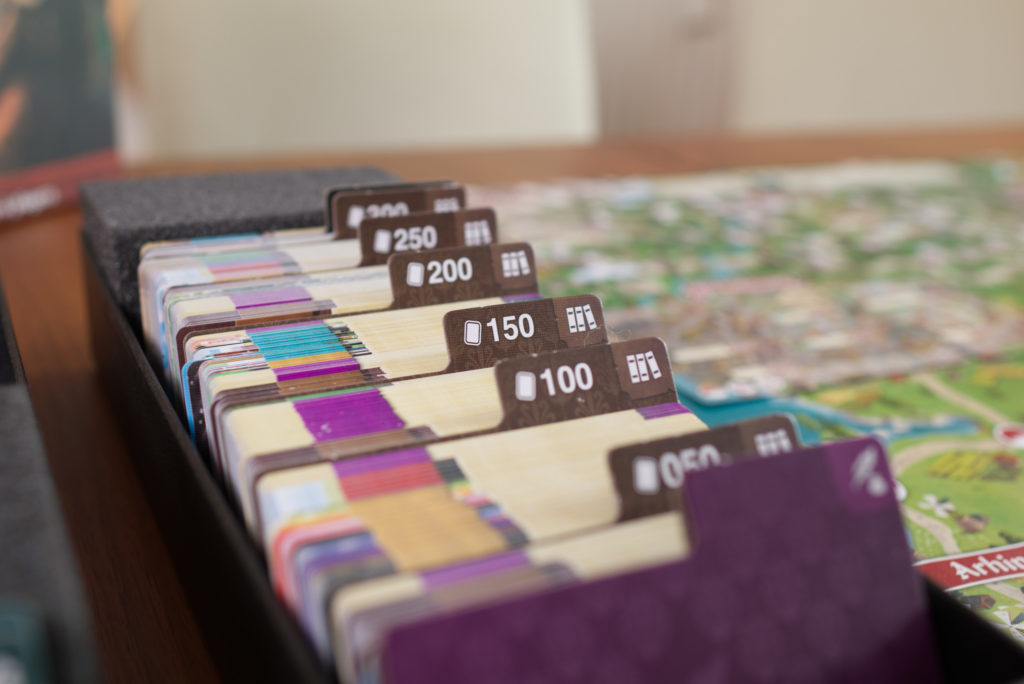
To sum it up, I appreciate Lands of Galyzr greatly for what it is trying to do and its biggest flaw for me personally is that it is succeeding so brilliantly in it. It’s a great piece of game design but needs a particular type of player to enjoy it. For me, it feels like playing in a sandbox without being given a shovel or any moulds. There is no castle I can build, no grant adventure to be had because in the end, it’s all just sand. And the sand is running through my fingers back into the sandbox, as if I would never had picked it up …
